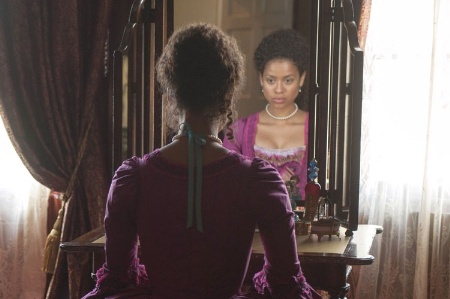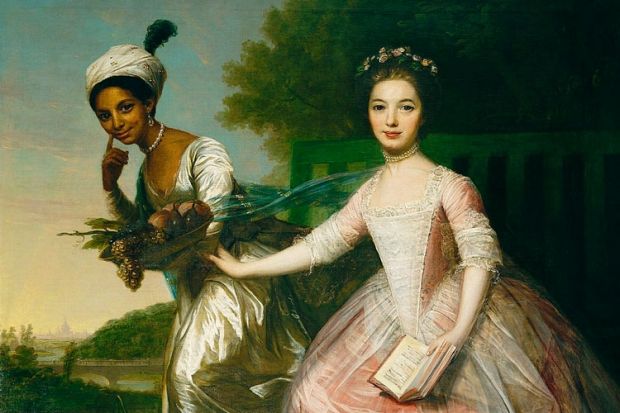Source: Picselect/From the collection of the Earl of Mansfield, Scone Palace, Perth
Portrait of a lady: the painting of Lord Mansfield’s wards, Belle and her cousin Elizabeth, inspired Amma Asante’s film
Belle
Directed by Amma Asante
Starring Gugu Mbatha-Raw, Tom Wilkinson, Sam Reid and Sarah Gadon
On general release in the UK from 13 June 2014
We are given an ethereal and empathetic focus through the film’s central character - cosseted in the lap of luxury, while at the same time denied her place at table
Another commercial feature film about a sympathetic black figure showing courage in the face of racism’s barbarity, struggling against myriad injustices: enter Belle, by award-winning Afro-British director, Amma Asante. This glossy period piece is inspired by the life of Dido Elizabeth Belle (c.1761-1804), the daughter of an enslaved woman, fathered by an admiral in the British Navy.
Orphaned at a young age, Belle was raised in the home of her great-uncle, the Earl of Mansfield, who would hand down key rulings relating to slavery during his tenure as Lord Chief Justice of England and Wales. During this era roughly 15,000 blacks were living in Britain, primarily in and around London, with many emancipated, but most still suffering legal limbo.
The remarkable story of Belle, raised in Kenwood House at a time of anxiety over colour and status, gained her some notoriety in her own day. Thomas Hutchinson, the loyalist governor of Massachusetts, visited Lord Mansfield’s Hampstead home in 1779 and commented in his diary:
“A Black came in after dinner and sat with the ladies and after coffee, walked with the company in the gardens, one of the young ladies having her arm within the other. She had a very high cap and her wool was much frizzled in her neck, but not enough to answer the large curls now in fashion. She is neither handsome nor genteel – pert enough…He [Lord Mansfield] calls her Dido, which I suppose is all the name she has. He knows he has been reproached for showing fondness for her – I dare say not criminal. A few years ago there was a cause before his Lordship bro’t by a Black for recovery of his liberty. A Jamaica planter being asked what judgement his Ldship would give? ‘No doubt’ he answered ‘He will be set free, for Lord Mansfield keeps a Black in his house which governs him and the whole family.’ ”
Hutchinson was referencing the decision in the landmark 1772 case, when the enslaved James Somerset petitioned to prevent his owner from returning him to Jamaica for sale. Lord Mansfield suggested slavery was “so odious, that nothing can be suffered to support it, but positive law”. Minus any statute, he declared Somerset to be set free.
This ruling was interpreted to mean that no one on British soil could be held as a slave, and thus was claimed by abolitionists as a victory. The reality that the overwhelming majority of those enslaved within the British Empire were held in bondage abroad did not dampen the enthusiasm of Granville Sharp and other antislavery radicals championing abolitionism.
Belle’s role and situation escaped fanfare and only resurfaced with the bicentenary of the abolition of the British slave trade in 2007. An exhibition at Kenwood featured the striking double portrait of Lord Mansfield’s female wards, Belle and her cousin, Lady Elizabeth Murray (formerly attributed to Johann Zoffany), which today hangs at Lord Mansfield’s ancestral home of Scone Palace, Scotland.
Unlike many paintings of the era, the dark-complexioned companion is not mere decoration. Nearly all images of persons of African descent in Western art objectify blacks and females. Yet in this portrait Lady Elizabeth’s hand on her cousin’s arm hints at warmth, familiarity, perhaps even a measure of equality. So this picture conveys a different story – a story that Asante fictionalises to embrace larger truths. The painting inspired the film’s melodramatic saga and allows for a portrayal every bit as romantic as its elegant canvas.

We are given an ethereal and empathetic focus through the film’s central character – cosseted in the lap of luxury, while at the same time denied her place at table. Asante offers a complex and rare take on slavery – a refracted perspective demonstrating how sexuality and status complicated racial dynamics. But the film hammers away at gender as well, showing the imprisonment of women, trapped within a system that determines their fate while denying them any say in the matter.
The beautiful woman in reduced circumstances is a stock character in fiction. A heroine with heaving bosoms and more charm than cash is a frequent cinematic ploy designed to lure teens to the cinema. Indeed, Belle is a good training exercise for Jane Austen fans, showcasing girls gambolling outdoors, sewing in parlours, scampering down corridors, escaping the humdrum via carriages, balls and marriage proposals. These heroines take every opportunity to bat eyelashes, confess secrets, engineer clandestine meetings and fall into hedgerows, alongside the swish of constant costume changes. Spurned lovers and potential fiancés inject themselves throughout the action.
Rachel Portman’s lush compositions offer some kind of sense memory, hinting at her previous musical scores for Douglas McGrath’s Emma (1996) and Saul Dibb’s The Duchess (2008). But Belle’s focus on racial prejudice means that it doesn’t just echo Pride and Prejudice.
Slavery’s corrosive consequences underscore the film. Belle features a particularly compelling scene where Dido (Gugu Mbatha-Raw) stares into the mirror, rubbing at her face, as if she might scour her colour away – an image that stays with the viewer long after the happy ending is contrived. The story suggests that the beautiful mixed-race daughter of a slave might have better odds in the marriage market than her dewy blonde but impoverished cousin. Dido at one point regards herself as “twice” freed – first by her father’s acknowledgement and emancipation, and then by his gift of a dowry. The second of these is a cinematic invention: in reality, Belle did not inherit from her father, who left money instead to two other illegitimate – and white – heirs. However, Lord Mansfield provided a settlement and annuity for his ward at his death, along with legal assurance that she was a free woman. Asante drives home hard the point that Lady Elizabeth’s (Sarah Gadon) lack of dowry puts her at a considerable disadvantage: Dido even offers a share of her inheritance to her titled relative to ease her distress.
Naturally, Belle’s heroine ends up with a worthy but undercapitalised lover – a legal apprentice played by Sam Reid – whom she formulaically spurns during the opening scenes before falling head over heels in love with him during abolitionist gatherings, garden parties and strolls by the sea. She breaks off her engagement with a gentleman of standing, casting aside security in favour of love, true love, just as her true lover defies custom and the colour line to pledge himself to her.
So Belle concludes quite conventionally, but also provides an alternative and untraditional B-story, that of a court ruling concerning a fiercely complicated slave insurance scandal. The Zong Case of 1783, where Lord Mansfield decided against the captain and crew of a ship who threw their slaves overboard, indeed proved a significant blow to the power of the slave owners. (The vessel had allegedly run out of food and water, and needed to preserve supplies, but in reality the human cargo was jettisoned to collect insurance.)
This history lesson is inserted somewhat artificially into the plot. Too often Belle’s characters are forced into lengthy expository dialogue that causes viewers to mentally reach for the mute button. These stilted interludes are counterbalanced by nuanced and brilliant performances by the adults: Tom Wilkinson, Emily Watson, Penelope Wilton and the saucy Miranda Richardson. The script goes to great lengths to provide viewers with a playbook, but in reality, we only require a moral compass, supplied by the colour-blinded young lovers.
These matters of life and death, laced with romance, heartbreak and intermittent historical interludes, are played out against the lush backdrop of Georgian England, with dramatic licence taken. Despite its lapses and liberties, Asante’s portrait of Belle is almost as astonishing as the painting that inspired the film. Neither may be great art, but each in its own way remains artful, and great.
Register to continue
Why register?
- Registration is free and only takes a moment
- Once registered, you can read 3 articles a month
- Sign up for our newsletter
Subscribe
Or subscribe for unlimited access to:
- Unlimited access to news, views, insights & reviews
- Digital editions
- Digital access to THE’s university and college rankings analysis
Already registered or a current subscriber? Login

